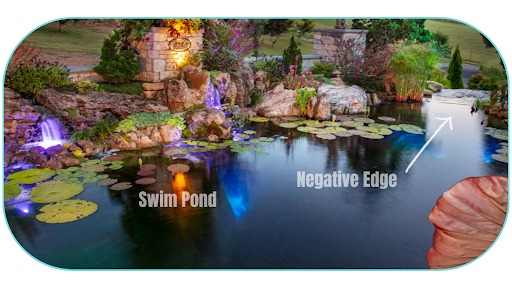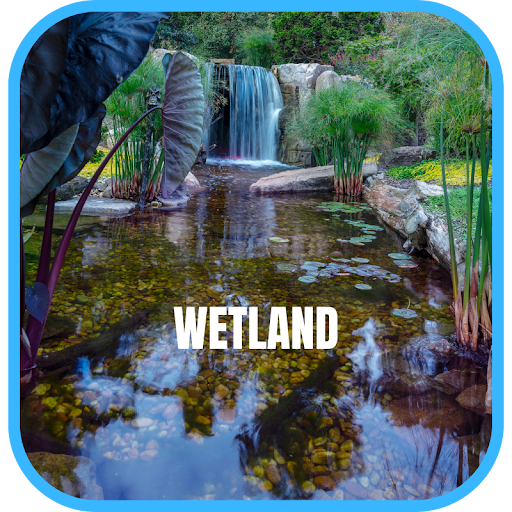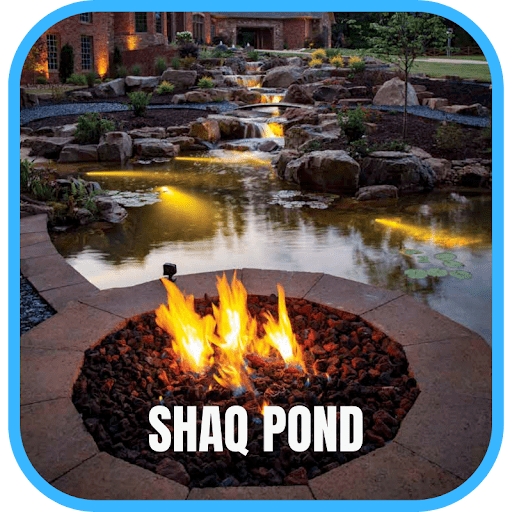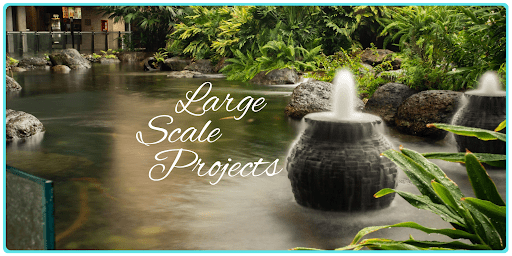Large-Scale Naturalistic Water Features: Costs, Process & Global Lessons
Author: John G Adams
Read Time: ~10 min
TL;DR: Large-scale naturalistic water features start around $150k locally and can scale into multimillion-dollar builds. They’re custom ecosystems—swim ponds, waterfalls, wetlands, and grottos—that look like nature put them there. Here’s what they cost, how we build them, and lessons from our global projects.
Hey folks, John Adams here from Modern Design Aquascaping. If you’ve been around our Learning Center, you know I love pulling back the curtain on how water features really get built. Today, we’re talking about the big ones—large-scale naturalistic water features.
These aren’t backyard fountains. They’re $150k to multimillion-dollar ecosystems: swim ponds, waterfalls, wetlands, and grottos that look like nature put them there. I’ve spent 25+ years building these projects across four continents, and along the way I’ve seen what works, what fails, and what to avoid.
In this guide, I’ll show you what makes a water feature “large-scale,” how much they cost, and the exact process we use to build them bulletproof. Plus, I’ll share lessons from our award-winning global projects so you know what it takes to get it right the first time.
What Makes a Water Feature Large-Scale?
Quick Answer: Large-scale naturalistic water features typically start at $250k and scale into millions. They’re designed to fool the eye into looking natural, using eco-friendly systems for clear water and low maintenance.
What determines if a feature is large scale? Typically for us it’s when a local project exceeds $150,000 price tag for a custom Koi pond, waterfall or fountain. For our out-of-town projects, $250,000 is a basic starting point. I’ve made you videos on what affects the cost of a pond and A complete web page on Large-Scale Water Features. These will give you lots of valuable information!
PRICING FROM SOME OF OUR PAST LARGE SCALE PROJECTS:
| Tier | Typical Cost | Features | Example Project |
|---|---|---|---|
| Entry-Level | $150k–$500k | Custom koi ponds, waterfalls, some advanced filtration | Backyard koi pond |
| Mid-Range | $500k–$1M | Recreation ponds, deep swim zones, wetland filters & intake bays | Outdoor Paradise |
| High-End | $1M+ | Commercial projects, large scale ponds and waterfalls, recreational swim ponds with upgrades. | Oasis At Modern Design |
Should I Choose A Naturalistic Design For My Water Feature?
It’s because a natural water feature screams out, “Relax, Enjoy, & Connect!” Replicating nature Ultimately It improves the way people spend time with the ones they love! People who prioritize exceptional outcomes over price want “water features that tell a story”. They want something that looks like it belongs, not something plopped in. That’s where our experience shines—we’ve built these uniquely customized, across the globe, always starting with a person’s vision (yours or your client’s) and guiding it to reality.


Why Does Finding the Right Builder Feel Like Gambling?
Let’s be honest—90% of water feature companies (and that’s probably a low estimate) aren’t as good as they claim. They might be book-smart or decent at small installs, but when it comes to large-scale artistry, they fall short.
For high-net-worth folks, the risk is huge. You’re investing serious money, and a bad contractor can turn your dream into a headache. Landscape architects face the same: you design based on vision, but if the builder can’t execute at an elite level, your reputation takes the hit.
That’s why our approach comes from a place of transparency. We’ve been the guide on projects from Tennessee backyards to commercial entrances, and we’ve learned that trust starts with answering your questions upfront. Questions like: How do you handle global logistics? What makes your designs “bulletproof” at scale? How much will this really cost? Let’s break it down.
Should You Build Large-Scale Naturalistic Water Features Differently?
At Modern Design Aquascaping, we don’t just build—we guide you through a process that’s amped up for large-scale projects. The rules of artistry stay the same (e.g., blending local materials for that fooling-the-eye look), but we scale everything to make it bulletproof. Here’s how we do it, step by step, with lessons from our global work.
1. Discovery and Vision Alignment: Starting with Your Story
- Every project begins with a conversation—no obligation, just figuring out if we’re a fit. We ask: What’s your dream? A swim pond for family gatherings? A zoo habitat that mimics nature? We listen, then share content like our “Pond Done Wrong” video to show what to avoid. Here’s our process for local jobs and also some optional Design Packages for you to think about.
- Lesson from the Field:
- Communication is everything.
- We ask better questions to make sure we’re all on the same page.
- We set expectations in every possible capacity.
- We learned that unexpected things always happen- but what defines us is how we handle them!
- Tip for You: If money isn’t the main concern, prioritize builders with proven artistry—like our 2013 Aquascape Artist of the Year win, which recognizes designs that trick the eye into thinking they’re natural.
2. Design and Planning: Scaling Artistry Without Losing Detail
- For large-scale features, we have a different set of rules. The basics are the same, but when we go out of town, it’s more important that things are bulletproof. We add in a lot of extra insurance during the construction process to make sure that simple problems don’t crop up unexpectedly.
- The Difference at Scale: the reality is as the project gets bigger, it’s a lot like dragging a mouse with a photo everything has to get bigger in unison. You can’t just keep building bigger and bigger and using the same size rocks you end up with a pearl necklace. Everything gets bigger, boulders, machinery, access, the mess, you name it. It’s across the board and scale is fun!
- Lesson from Global Builds: In Colombia’s Primavera Urbana Mall (2017), as part of an Aquascape Artist of the Year team, we scaled a massive waterfall to blend with urban architecture—fooling the eye into an oasis feel. Similarly, our 5000 sq ft wetland filter in Velva, ND (2022) used amplified eco-filtration to keep a man-made lake crystal-clear.

3. Collaboration and Team Assembly: Going Where the Vision Takes Us
- For nationwide or international projects, we travel and assemble elite teams—often Aquascape partners or Artist of the Year winners. We’ve built on four continents, from U.S. states like New York to Florida, to Africa and England.
- Lesson: In Uganda and Ghana (four Aquascape Foundation trips, 2013–2020), we volunteered and donated our time to help build rainwater systems capturing the rain to bring clean water to places that need it. This taught us to adapt designs globally without losing detail. (Watch: Water For Africa.)
- For Landscape Architects: We love partnering—sell the vision, we’ll execute the artistry. Our track record (e.g., installing larger scale for JVI Secret Gardens in Nashville) shows we knock it out of the park, even on someone-else’s overflow work.

4. Construction: How to Amp Up for Bulletproof Quality
- Large-scale means bigger challenges:
- heavier boulders (e.g. 23-ton boulder in Denver)
- Deeper excavations (6+ feet for swim ponds)
- Amplified eco-system filters (e.g., wetland filters and intake bays for 15,000+ gallons).
- Key Amp-Ups:
- Reinforced liners for stability
- Enhanced levels of liner protection for longevity
- Multiple pumps for increased circulation and filtration,
- Increased liner height above water level
- Layered stones and plants for that fooling-the-eye effect
We test everything—circulation, sound, ecology—to ensure low maintenance.
- Lesson from Zoos: At Lincoln Park Zoo (Chicago, early 2010s), our Aquascape collaboration amped up filters for flamingo habitats, creating naturalistic, durable designs that withstand daily use. We’ve helped build water features for alligator snapping turtles, spider monkeys, Gibbons, and water fowl.
5. Finishing and Maintenance: Ensuring Long-Term Success
- We don’t just build—we guide post-install with maintenance plans. Large features need amped monitoring (e.g., remote sensors for international sites).
- Lesson: Our Oasis in Friendsville, TN—a multimillion naturalistic masterpiece—incorporates everything from grottos to swim ponds. It’s our living lab, inviting clients to see fooling-the-eye artistry in action. (Building The Oasis.)

Cost Considerations: Transparency on Large-Scale Builds
One of the biggest questions I get: “How much does a large-scale naturalistic water feature cost?” Let’s break it down—no smoke and mirrors.
- Entry-Level Large-Scale (e.g., Custom Koi Pond, $150k–$500k): Basic naturalistic designs with waterfalls and filtration. Factors: Size (1,000 sq ft+), materials (local stone vs. imported), site prep (e.g., excavation in rocky terrain adds 20%).
- Mid-Range (e.g., Recreation Pond, $500k–$1M): Amped features like swim zones, fire boulders, and wetland filters. Travel/logistics for international: Add 10-20% (e.g., our Colombia build).
- High-End Global (e.g., Large swim pond, massive waterfalls, or Zoo Habitat, $1M+): Fully custom, fooling-the-eye artistry with grottos, streams, and eco-systems. Costs scale with complexity (e.g., our Denver pond: 5+ years, phased for budget control).
What affects costs? Location (international shipping amps it up), scale (bigger means more materials), and artistry (our award-winning details ensure value). We start with a no-pressure conversation—often $20k consultations to outline plans.
Real-World Success: Our Global Projects as Proof
We’ve been blessed to be a part of projects across 4 continents and 14+ U.S. states. Here are highlights, showing how our naturalistic artistry delivers exceptional outcomes.

Shaquille O’Neal Water Feature, Atlanta, Georgia (2020):
As part of an Aquascape-coordinated team of Artist of the Year winners (including our 2013 title), Tristan and I built a 22-by-50-foot ecosystem pond with a 70-foot stream. I spearheaded the fire pit and carnivorous plant bog, adding fooling-the-eye details. (YouTube: “SHAQ GETS A CRAZY AWESOME POND BUILT”.)
Multimillion-Dollar Swim Pond, Denver, Colorado (2019–Present):
Helping guide homeowners on building their own naturalistic retreat that spans an entire back-yard in Cherry Hills. (YouTube: “Denver’s Best Swim Pond”.)
Bluewater Manor Custom Pond, Lake George, New York (2018–2019):
Tristan and I collaborated with DeFranco Landscaping and a team of elite water feature artists, including fellow Aquascape Artist of the Year winner Sean Frost (NatureScapes).“See the video: Killer Water Feature Build at Blue Water Manor Resort”.
Primavera Urbana Mall, Colombia (2017):
Aquascape Artist of the Year team collaboration for an urban oasis.
Aquascape Foundation, Uganda/Ghana (2013–2020):
Volunteered on rainwater systems for thousands.
Pond College Waterfall, England (2022):
Led fundraiser for our own Sawyer Mason Foundation. SawyerMasonFoundation.org
Zoo Habitats (e.g., Lincoln Park Zoo, Chicago):
Naturalistic filters for animals.
Our Oasis, Tennessee: Multimillion fooling-the-eye showcase.
(Oasis Reveal-Natural Swim Pond)
These aren’t just projects—they’re successes that inspire trust.
FAQ: Large-Scale Naturalistic Water Features
What makes a water feature “large-scale”?
For us, a water feature becomes “large-scale” when it crosses certain price thresholds. Locally, that means $150k or more for a koi pond, waterfall, or fountain. For out-of-town projects, $250k is the basic starting point. These projects go beyond backyard fountains—they’re full ecosystems with custom artistry and engineering.
How much does a large-scale naturalistic water feature cost?
Large-scale naturalistic water features typically start around $250k and scale into the millions. Entry-level builds like custom koi ponds run $150k–$500k, mid-range recreation ponds are $500k–$1M, and high-end global projects—like zoo habitats or multimillion-dollar swim ponds—start at $1M+. Factors include size, materials, site prep, logistics, and the level of artistry. Check out our Ponds Page for more information.
What’s the difference between a naturalistic water feature and a man-made one?
A naturalistic water feature looks like it belongs. It blends into the landscape with rocks, fish, plants, and flowing water that feels organic—like something you’d stumble upon in the mountains. A man-made water feature, on the other hand, can feel contrived. Sometimes it’s intentional, like with formal designs that use straight lines and right angles. But when it’s unintentional, it just looks like a poor replica of nature.
How long does it take to build a large-scale water feature?
Timelines vary. Our team has built large-scale features in as little as two weeks, but some of the biggest projects we’ve tackled have taken months. It depends on size, complexity, and site logistics.
What should I look for in a builder for a project this size?
Experience—100%. I even made a video called Hire Smarter about choosing the right contractor. Don’t let someone practice on your project or learn their mistakes in your backyard. Look for proof of past work, years of experience, and artistry at scale. The right builder should have a track record of success you can see and trust.
Your Next Step: Let’s Chat About Your Dream Feature
Be the hero in your own story, it all starts with a simple conversation! Whether transforming your estate or designing for a client, fill out our contact form for a no-obligation conversation. We’ll guide you to the right plan, answer questions, and see if we’re a fit. No pressure—just an open-honest conversation to help lead you toward the water feature of your dreams.
Ready? Contact Us Here.
Thanks for reading—let’s make some magic!
John G Adams
Modern Design Aquascaping
Last Updated: September 3, 2025

